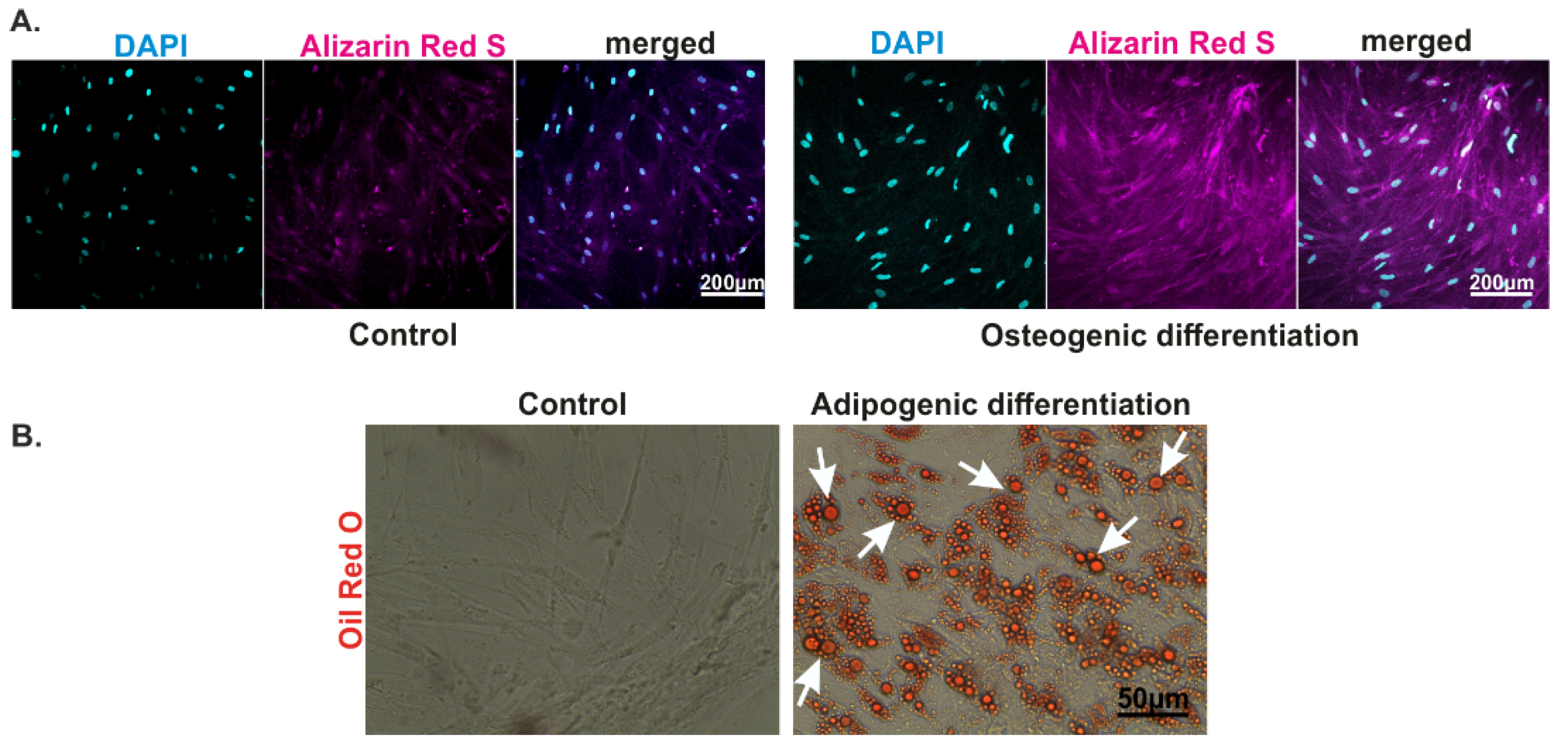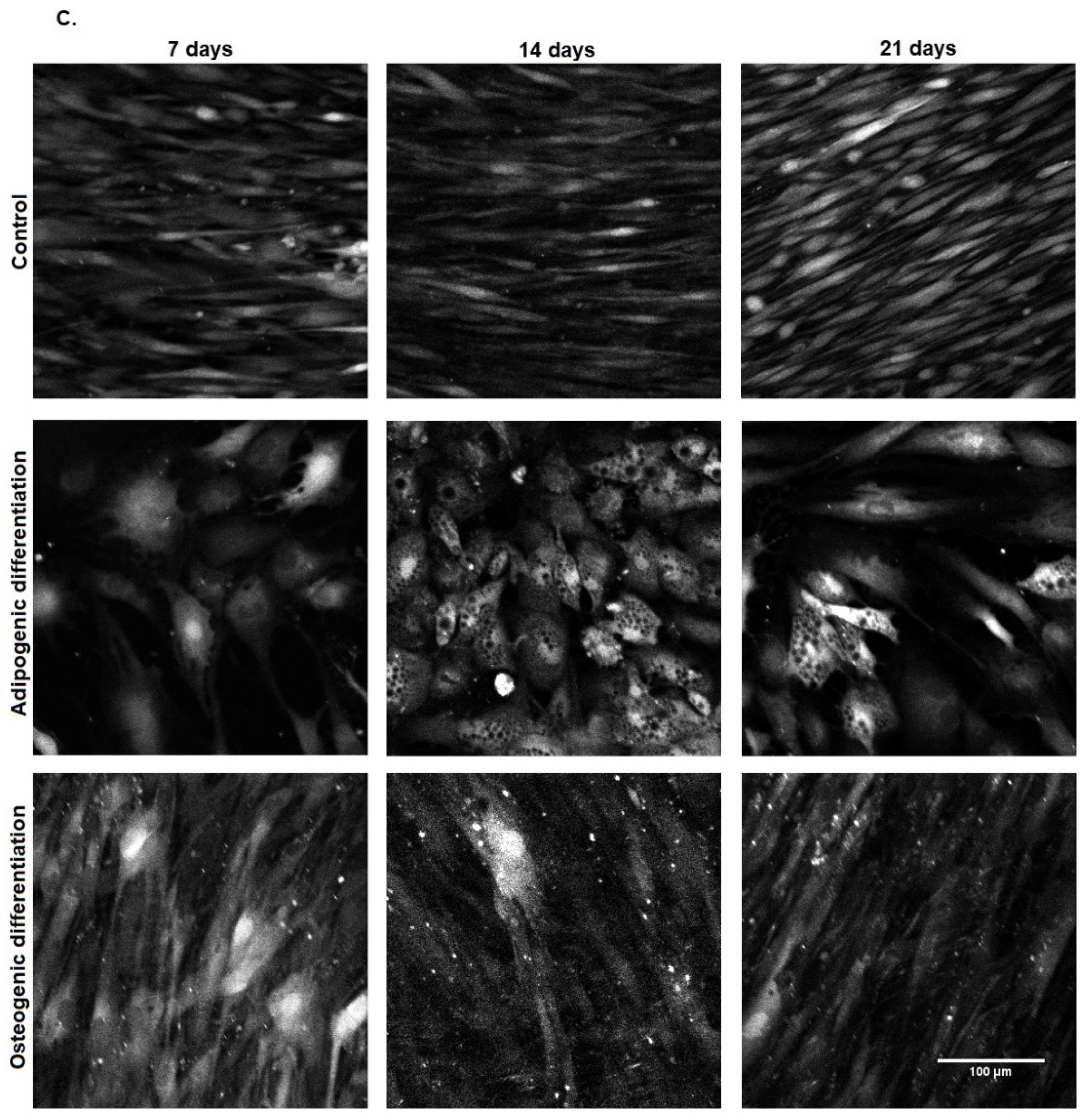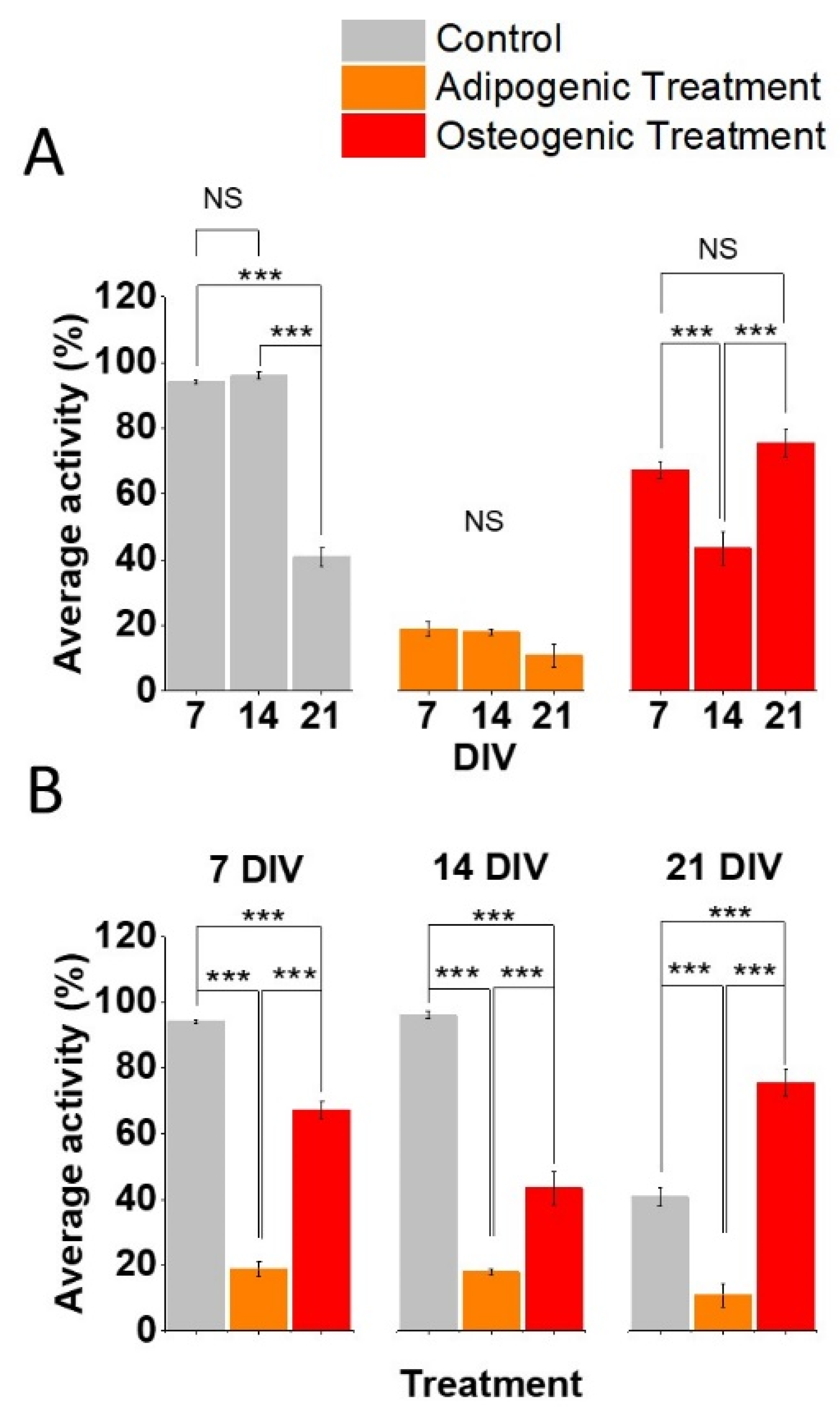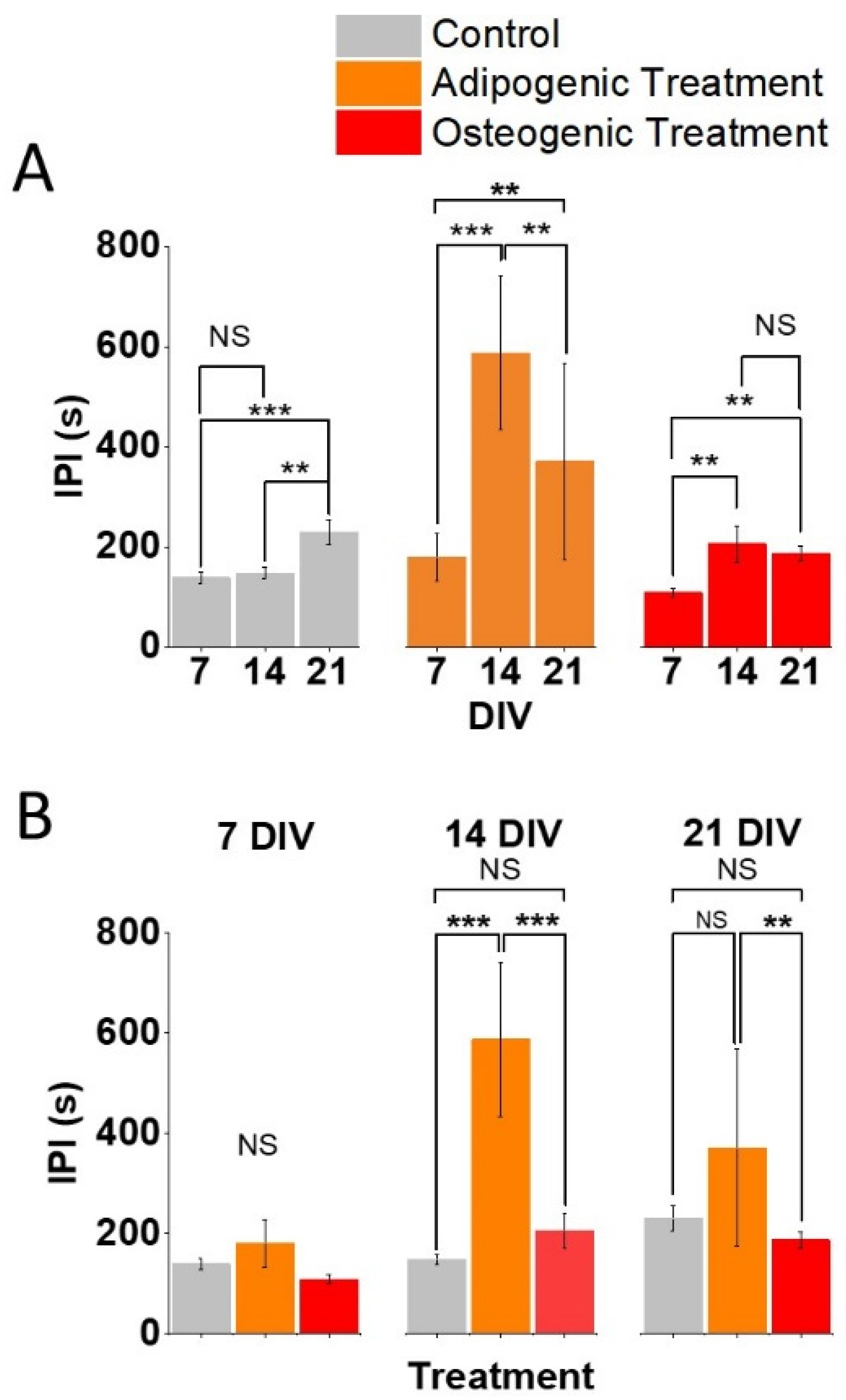Time-Dependent Reduction of Calcium Oscillations in Adipose-Derived Stem Cells Differentiating towards Adipogenic and Osteogenic Lineage
Abstract
:1. Introduction
2. Materials and Methods
2.1. Cultivation of Human ASCs
2.2. Osteogenic Differentiation
2.3. Adipogenic Differentiation
2.4. Calcium Imaging
2.5. Image Processing and Analysis
2.6. Cell Activity
2.7. Interpeak Interval
2.8. Statistical Analysis
3. Results
3.1. Effect of Time on Ca2+ Aynamics in ASCs Undergoing Separate Differentiation Aaths
3.2. Effect of Osteogenic and Adipogenic Aifferentiation on Ca2+ Aynamics in ASCs at Aifferent Timepoints
4. Discussion
5. Conclusions
Supplementary Materials
Author Contributions
Funding
Institutional Review Board Statement
Informed Consent Statement
Data Availability Statement
Conflicts of Interest
References
- Andrzejewska, A.; Lukomska, B.; Janowski, M. Concise Review: Mesenchymal Stem Cells: From Roots to Boost. Stem Cells 2019, 37, 855–864. [Google Scholar] [CrossRef] [Green Version]
- Kharaziha, P.; Hellström, P.M.; Noorinayer, B.; Farzaneh, F.; Aghajani, K.; Jafari, F.; Telkabadi, M.; Atashi, A.; Honardoost, M.; Zali, M.R.; et al. Improvement of liver function in liver cirrhosis patients after autologous mesenchymal stem cell injection: A phase I–II clinical trial. Eur. J. Gastroenterol. Hepatol. 2009, 21, 1199–1205. [Google Scholar] [CrossRef] [PubMed]
- Mathiasen, A.B.; Qayyum, A.A.; Jorgensen, E.; Helqvist, S.; Fischer-Nielsen, A.; Kofoed, K.F.; Haack-Sørensen, M.; Ekblond, A.; Kastrup, J. Bone marrow-derived mesenchy-mal stromal cell treatment in patients with severe ischaemic heart failure: A randomized placebo-controlled trial (MSC-HF trial). Eur. Heart. J. 2015, 36, 1744–1753. [Google Scholar] [CrossRef] [Green Version]
- Connick, P.; Kolappan, M.; Patani, R.; Scott, M.A.; Crawley, C.; He, X.L.; Richardson, K.; Barber, K.; Webber, D.J.; Wheeler-Kingshott, C.A.M.; et al. The mesenchymal stem cells in multiple sclerosis (MSCIMS) trial protocol and baseline cohort characteristics: An open-label pre-test: Post-test study with blinded outcome as-sessments. Trials 2011, 12, 62. [Google Scholar] [CrossRef] [Green Version]
- Sharma, R.R.; Pollock, K.; Hubel, A.; McKenna, D. Mesenchymal stem or stromal cells: A review of clinical applications and man-ufacturing practices. Transfusion 2014, 54, 1418–1437. [Google Scholar] [CrossRef]
- Lee, R.H.; Pulin, A.; Seo, M.J.; Kota, D.J.; Ylostalo, J.; Larson, B.L.; Semprun-Prieto, L.; Delafontaine, P.; Prockop, D.J. Intravenous hMSCs Improve Myocardial Infarction in Mice because Cells Embolized in Lung Are Activated to Secrete the Anti-inflammatory Protein TSG-6. Cell Stem Cell 2009, 5, 54–63. [Google Scholar] [CrossRef] [PubMed] [Green Version]
- Zanotti, L.; Sarukhan, A.; Dander, E.; Castor, M.; Cibella, J.; Soldani, C.; Trovato, A.E.; Ploia, C.; Luca, G.; Calvitti, M.; et al. Encapsulated mesenchymal stem cells for in vivo im-munomodulation. Leukemia 2013, 27, 500–503. [Google Scholar] [CrossRef] [PubMed]
- Timmers, L.; Lim, S.K.; Arslan, F.; Armstrong, J.S.; Hoefer, I.E.; Doevendans, P.A.; Piek, J.J.; El Oakley, R.M.; Choo, A.; Lee, C.N.; et al. Reduction of myocardial infarct size by human mesenchymal stem cell conditioned medium. Stem Cell Res. 2008, 1, 129–137. [Google Scholar] [CrossRef] [Green Version]
- Gnecchi, M.; He, H.; Liang, O.D.; Melo, L.G.; Morello, F.; Mu, H.; Noiseux, N.; Zhang, L.; Pratt, R.E.; Ingwall, J.S.; et al. Paracrine action accounts for marked protection of ischemic heart by Akt-modified mesenchymal stem cells. Nat. Med. 2005, 11, 367–368. [Google Scholar] [CrossRef]
- Gnecchi, M.; He, H.; Noiseux, N.; Liang, O.D.; Zhang, L.; Morello, F.; Mu, H.; Melo, L.G.; Pratt, R.E.; Ingwall, J.S.; et al. Evidence supporting paracrine hypothesis for Akt-modified mesenchymal stem cell-mediated cardiac protection and functional improvement. FASEB J. 2006, 20, 661–669. [Google Scholar] [CrossRef] [PubMed]
- Zuk, P.A.; Zhu, M.; Ashjian, P.; De Ugarte, D.A.; Huang, J.I.; Mizuno, H.; Alfonso, Z.C.; Fraser, J.K.; Benhaim, P.; Hedrick, M.H. Human Adipose Tissue Is a Source of Multipotent Stem Cells. Mol. Biol. Cell 2002, 13, 4279–4295. [Google Scholar] [CrossRef] [PubMed]
- Gimble, J.; Guilak, F. Adipose-derived adult stem cells: Isolation, characterization, and differentiation potential. Cytotherapy 2003, 5, 362–369. [Google Scholar] [CrossRef] [PubMed]
- Jervis, M.; Huaman, O.; Cahuascanco, B.; Bahamonde, J.; Cortez, J.; Arias, J.I.; Torres, C.G.; Peralta, O.A. Comparative analysis of in vitro proliferative, migratory and pro-angiogenic potentials of bovine fetal mesenchymal stem cells derived from bone marrow and adipose tissue. Vet. Res. Commun. 2019, 43, 165–178. [Google Scholar] [CrossRef] [PubMed]
- Mitchell, R.; Mellows, B.; Sheard, J.; Antonioli, M.; Kretz, O.; Chambers, D.; Zeuner, M.-T.; Tomkins, J.; Denecke, B.; Musante, L.; et al. Secretome of adipose-derived mesenchymal stem cells promotes skeletal muscle regeneration through synergistic action of extracellular vesicle cargo and soluble proteins. Stem Cell Res. Ther. 2019, 10, 116. [Google Scholar] [CrossRef] [PubMed]
- Liu, Y.; Holmes, C. Tissue Regeneration Capacity of Extracellular Vesicles Isolated From Bone Marrow-Derived and Adi-pose-Derived Mesenchymal Stromal/Stem Cells. Front. Cell Dev. Biol. 2021, 9, 308. [Google Scholar]
- Whitfield, J.F. Calcium Signals in Cell Proliferation, Differentiation, and Death. In Ion Channels and Ion Pumps: Metabolic and Endocrine Relationships in Biology and Clinical Medicine; Foà, P.P., Walsh, M.F., Eds.; Springer: New York, NY, USA, 1994; pp. 19–58. [Google Scholar]
- Berridge, M.J.; Bootman, M.; Lipp, P. Calcium—A life and death signal. Nature 1998, 395, 645–648. [Google Scholar] [CrossRef] [PubMed]
- De Pittà, M.; Volman, V.; Levine, H.; Pioggia, G.; De Rossi, D.; Ben-Jacob, E. Coexistence of amplitude and frequency modulations in intracellular calcium dynamics. Phys. Rev. E 2008, 77, 030903. [Google Scholar] [CrossRef] [Green Version]
- Kawano, S.; Shoji, S.; Ichinose, S.; Yamagata, K.; Tagami, M.; Hiraoka, M. Characterization of Ca2+ signaling pathways in human mesenchymal stem cells. Cell Calcium 2002, 32, 165–174. [Google Scholar] [CrossRef]
- Hanna, H.; Andre, F.M.; Mir, L.M. Electrical control of calcium oscillations in mesenchymal stem cells using microsecond pulsed electric fields. Stem Cell Res. Ther. 2017, 8, 91. [Google Scholar] [CrossRef] [Green Version]
- Kawano, S.; Otsu, K.; Kuruma, A.; Shoji, S.; Yanagida, E.; Muto, Y.; Yoshikawa, F.; Hirayama, Y.; Mikoshiba, K.; Furuichi, T. ATP autocrine/paracrine signaling induces calcium oscilla-tions and NFAT activation in human mesenchymal stem cells. Cell Calcium 2006, 39, 313–324. [Google Scholar] [CrossRef]
- Kawano, S.; Otsu, K.; Shoji, S.; Yamagata, K.; Hiraoka, M. Ca2+ oscillations regulated by Na+–Ca2+ exchanger and plasma mem-brane Ca2+ pump induce fluctuations of membrane currents and potentials in human mesenchymal stem cells. Cell Calcium 2003, 34, 145–156. [Google Scholar] [CrossRef]
- Gu, X.; Spitzer, N. Breaking the Code: Regulation of Neuronal Differentiation by Spontaneous Calcium Transients. Dev. Neurosci. 1997, 19, 33–41. [Google Scholar] [CrossRef]
- Resende, R.; Adhikari, A.; da Costa, J.; Lorençon, E.; Ladeira, M.; Guatimosim, S.; Kihara, A.; Ladeira, L. Influence of spontaneous calcium events on cell-cycle progression in embryonal carcinoma and adult stem cells. Biochim. Biophys. Acta (BBA)-Bioenerg. 2010, 1803, 246–260. [Google Scholar] [CrossRef] [Green Version]
- Dominici, M.; Le Blanc, K.; Mueller, I.; Slaper-Cortenbach, I.; Marini, F.; Krause, D.; Deans, R.; Keating, A.; Prockop, D.; Horwitz, E. Minimal criteria for defining multipotent mesenchymal stromal cells. The International Society for Cellular Therapy position statement. Cytotherapy 2006, 8, 315–317. [Google Scholar] [CrossRef] [PubMed]
- Bicer, M.; Sheard, J.; Iandolo, D.; Boateng, S.Y.; Cottrell, G.S.; Widera, D. Electrical Stimulation of Adipose-Derived Stem Cells in 3D Nanofibrillar Cellulose Increases Their Osteogenic Potential. Biomolecules 2020, 10, 1696. [Google Scholar] [CrossRef] [PubMed]
- Bicer, M.; Cottrell, G.S.; Widera, D. Impact of 3D cell culture on bone regeneration potential of mesenchymal stromal cells. Stem Cell Res. Ther. 2021, 12, 31. [Google Scholar] [CrossRef] [PubMed]
- Schindelin, J.; Arganda-Carreras, I.; Frise, E.; Kaynig, V.; Longair, M.; Pietzsch, T.; Preibisch, S.; Rueden, C.; Saalfeld, S.; Schmid, B.; et al. Fiji: An open-source platform for biologi-cal-image analysis. Nat. Methods 2012, 9, 676–682. [Google Scholar] [CrossRef] [Green Version]
- Winkel, A.; Jaimes, Y.; Melzer, C.; Dillschneider, P.; Hartwig, H.; Stiesch, M.; Von Der Ohe, J.; Strauss, S.; Vogt, P.M.; Hamm, A.; et al. Cell culture media notably influence properties of human mesenchymal stroma/stem-like cells from different tissues. Cytotherapy 2020, 22, 653–668. [Google Scholar] [CrossRef] [PubMed]
- Shi, H.; Halvorsen, Y.-D.; Ellis, P.N.; Wilkison, W.O.; Zemel, M. Role of intracellular calcium in human adipocyte differentiation. Physiol. Genom. 2000, 3, 75–82. [Google Scholar] [CrossRef]
- Zhai, M.; Yang, D.; Yi, W.; Sun, W. Involvement of calcium channels in the regulation of adipogenesis. Adipocyte 2020, 9, 132–141. [Google Scholar] [CrossRef] [Green Version]
- Berridge, M.J.; Bootman, M.; Roderick, H. Calcium signalling: Dynamics, homeostasis and remodelling. Nat. Rev. Mol. Cell Biol. 2003, 4, 517–529. [Google Scholar] [CrossRef] [Green Version]
- Hanna, H.; Mir, L.M.; Andre, F.M. In vitro osteoblastic differentiation of mesenchymal stem cells generates cell layers with dis-tinct properties. Stem Cell Res. Ther. 2018, 9, 203. [Google Scholar] [CrossRef] [PubMed]
- Viti, F.; Landini, M.; Mezzelani, A.; Petecchia, L.; Milanesi, L.; Scaglione, S. Osteogenic Differentiation of MSC through Calcium Signaling Activation: Transcriptomics and Functional Analysis. PLoS ONE 2016, 11, e0148173. [Google Scholar] [CrossRef] [Green Version]
- Sun, S.; Liu, Y.; Lipsky, S.; Cho, M. Physical manipulation of calcium oscillations facilitates osteo differentiation of human mesen-chymal stem cells. FASEB J. 2007, 21, 1472–1480. [Google Scholar] [CrossRef] [PubMed] [Green Version]
- Titushkin, I.; Sun, S.; Shin, J.; Cho, M. Physicochemical control of adult stem cell differentiation: Shedding light on potential mo-lecular mechanisms. J. Biomed. Biotechnol. 2010, 2010, 743476. [Google Scholar] [CrossRef] [PubMed]
- Khatib, L.; Golan, D.E.; Cho, M. Physiologic electrical stimulation provokes intracellular calcium increase mediated by phospho-lipase C activation in human osteoblasts. FASEB J. 2004, 18, 1903–1905. [Google Scholar] [CrossRef]




| Treatment | DIV (I) | DIV (J) | Fraction of Active Cells | Interpeak Intervals | ||
|---|---|---|---|---|---|---|
| Effect Size (Mean Difference: I–J) | p (Bonferroni Corrected) | Effect Size (Mean Difference: I–J) | p (Bonferroni Corrected) | |||
| control | 7 | 14 | −1.985 | 1.000 | −9.020 | 1.000 |
| 21 | 53.274 | <0.001 | −91.319 | 0.001 | ||
| 14 | 7 | 1.985 | 1.000 | 9.020 | 1.000 | |
| 21 | 55.258 | <0.001 | −82.298 | 0.016 | ||
| 21 | 7 | −53.274 | <0.001 | 91.319 | 0.001 | |
| 14 | −55.258 | <0.001 | 82.298 | 0.016 | ||
| adipogenic | 7 | 14 | 0.932 | 1.000 | −407.050 | 0.000 |
| 21 | 7.944 | 0.130 | −190.274 | 0.017 | ||
| 14 | 7 | −0.932 | 1.000 | 407.050 | 0.000 | |
| 21 | 7.013 | 0.244 | 216.776 | 0.030 | ||
| 21 | 7 | −7.944 | 0.130 | 190.274 | 0.017 | |
| 14 | −7.013 | 0.244 | −216.776 | 0.030 | ||
| osteogenic | 7 | 14 | 23.905 | <0.001 | −96.869 | 0.005 |
| 21 | −8.124 | 0.187 | −77.912 | 0.011 | ||
| 14 | 7 | −23.905 | <0.001 | 96.869 | 0.005 | |
| 21 | −32.029 | <0.001 | 18.957 | 1.000 | ||
| 21 | 7 | 8.124 | 0.187 | 77.912 | 0.011 | |
| 14 | 32.029 | <0.001 | −18.957 | 1.000 | ||
| DIV | Treatment (I) | Treatment (J) | Fraction of Active Cells | Interpeak Intervals | ||
|---|---|---|---|---|---|---|
| Effect Size (Mean Difference: I–J) | p (Bonferroni Corrected) | Mean Difference (I–J) | p (Bonferroni Corrected) | |||
| 7 | control | adipogenic | 75.226 | <0.001 | −41.435 | 0.965 |
| osteogenic | 26.774 | <0.001 | 30.031 | 0.510 | ||
| adipogenic | control | −75.226 | <0.001 | 41.435 | 0.965 | |
| osteogenic | −48.451 | <0.001 | 71.466 | 0.287 | ||
| osteo | control | −26.774 | <0.001 | −30.031 | 0.510 | |
| adipogenic | 48.451 | <0.001 | −71.466 | 0.287 | ||
| 14 | control | adipogenic | 78.142 | <0.001 | −439.465 | <0.001 |
| osteogenic | 52.664 | <0.001 | −57.818 | 0.236 | ||
| adipogenic | control | −78.142 | <0.001 | 439.465 | <0.001 | |
| osteogenic | −25.478 | <0.001 | 381.647 | <0.001 | ||
| osteogenic | control | −52.664 | <0.001 | 57.818 | 0.236 | |
| adipogenic | 25.478 | <0.001 | −381.647 | <0.001 | ||
| 21 | control | adipogenic | 29.896 | <0.001 | −140.390 | 0.056 |
| osteogenic | −34.623 | <0.001 | 43.437 | 0.418 | ||
| adipogenic | control | −29.896 | <0.001 | 140.390 | 0.056 | |
| osteogenic | −64.520 | <0.001 | 183.827 | 0.006 | ||
| osteogenic | control | 34.623 | <0.001 | −43.437 | 0.418 | |
| adipogenic | 64.520 | <0.001 | −183.827 | 0.006 | ||
Publisher’s Note: MDPI stays neutral with regard to jurisdictional claims in published maps and institutional affiliations. |
© 2021 by the authors. Licensee MDPI, Basel, Switzerland. This article is an open access article distributed under the terms and conditions of the Creative Commons Attribution (CC BY) license (https://creativecommons.org/licenses/by/4.0/).
Share and Cite
Torre, E.C.; Bicer, M.; Cottrell, G.S.; Widera, D.; Tamagnini, F. Time-Dependent Reduction of Calcium Oscillations in Adipose-Derived Stem Cells Differentiating towards Adipogenic and Osteogenic Lineage. Biomolecules 2021, 11, 1400. https://doi.org/10.3390/biom11101400
Torre EC, Bicer M, Cottrell GS, Widera D, Tamagnini F. Time-Dependent Reduction of Calcium Oscillations in Adipose-Derived Stem Cells Differentiating towards Adipogenic and Osteogenic Lineage. Biomolecules. 2021; 11(10):1400. https://doi.org/10.3390/biom11101400
Chicago/Turabian StyleTorre, Enrico C., Mesude Bicer, Graeme S. Cottrell, Darius Widera, and Francesco Tamagnini. 2021. "Time-Dependent Reduction of Calcium Oscillations in Adipose-Derived Stem Cells Differentiating towards Adipogenic and Osteogenic Lineage" Biomolecules 11, no. 10: 1400. https://doi.org/10.3390/biom11101400
APA StyleTorre, E. C., Bicer, M., Cottrell, G. S., Widera, D., & Tamagnini, F. (2021). Time-Dependent Reduction of Calcium Oscillations in Adipose-Derived Stem Cells Differentiating towards Adipogenic and Osteogenic Lineage. Biomolecules, 11(10), 1400. https://doi.org/10.3390/biom11101400









